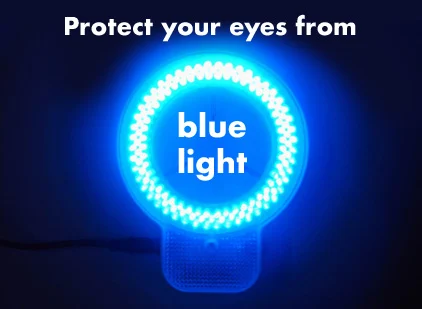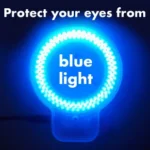In our increasingly digital world, concerns about blue light exposure from smartphones, computers, and tablets have grown significantly. With the average person spending over 7 hours daily looking at screens, understanding the impact of blue light on eye health has become crucial for maintaining optimal vision. This comprehensive guide explores the effects of digital device usage on ocular health and provides practical solutions for protection.
What is Blue Light and Where Does it Come From?

Blue light is a high-energy visible (HEV) light with wavelengths between 380-500 nanometers. It occurs naturally in sunlight and is also emitted by artificial sources including LED lights, fluorescent bulbs, and digital screens.
Natural Sources:
- Sunlight (the primary and strongest source)
- Sky during daytime hours
- Reflected light from water and snow
Artificial Sources:
- Computer monitors and laptop screens
- Smartphones and tablets
- LED and CFL light bulbs
- Television screens
- Gaming devices and e-readers
While blue light exposure from digital devices is significantly lower than natural sunlight, the close proximity and extended duration of screen use has raised concerns about potential cumulative effects on eye health.
Effects of Blue Light on Eye Health
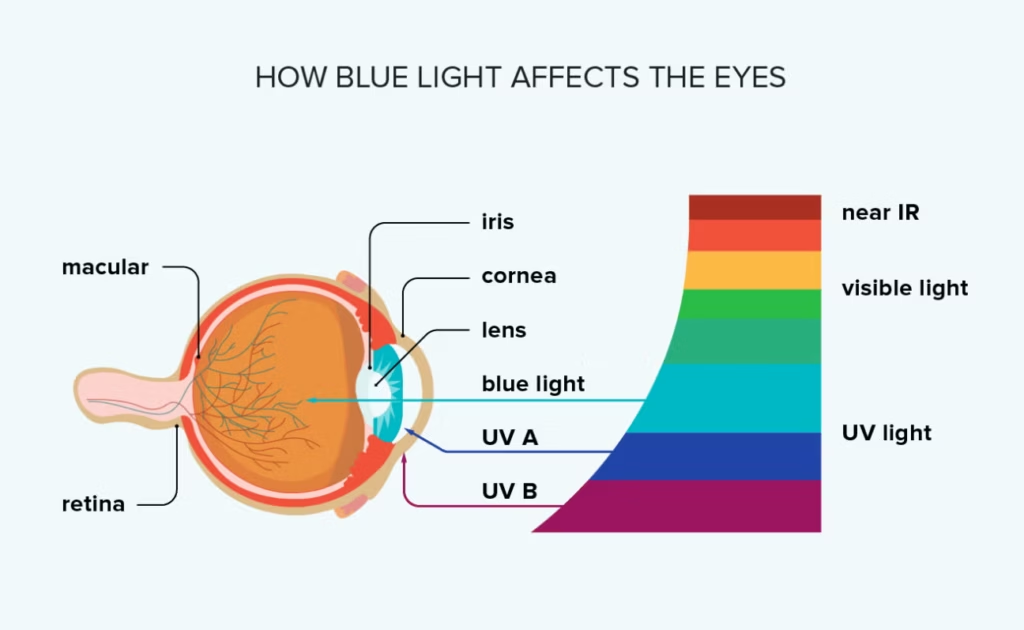
Research on blue light’s impact on ocular health reveals both established facts and ongoing investigations:
Immediate Effects:
- Digital eye strain and computer vision syndrome
- Increased eye fatigue and discomfort
- Reduced blink rate leading to dry eyes
- Difficulty focusing and maintaining clear vision
- Headaches and neck tension from screen use
Potential Long-term Concerns:
- Disruption of circadian rhythms and sleep patterns
- Possible contribution to age-related macular degeneration (AMD)
- Accelerated aging of retinal cells in laboratory studies
- Increased oxidative stress in eye tissues
Current Scientific Understanding: While some studies suggest potential risks, the scientific community has not reached consensus on whether typical blue light exposure from digital devices causes permanent eye damage. Most eye care professionals agree that digital eye strain is real, but debate continues about long-term retinal effects.
Symptoms of Digital Eye Strain
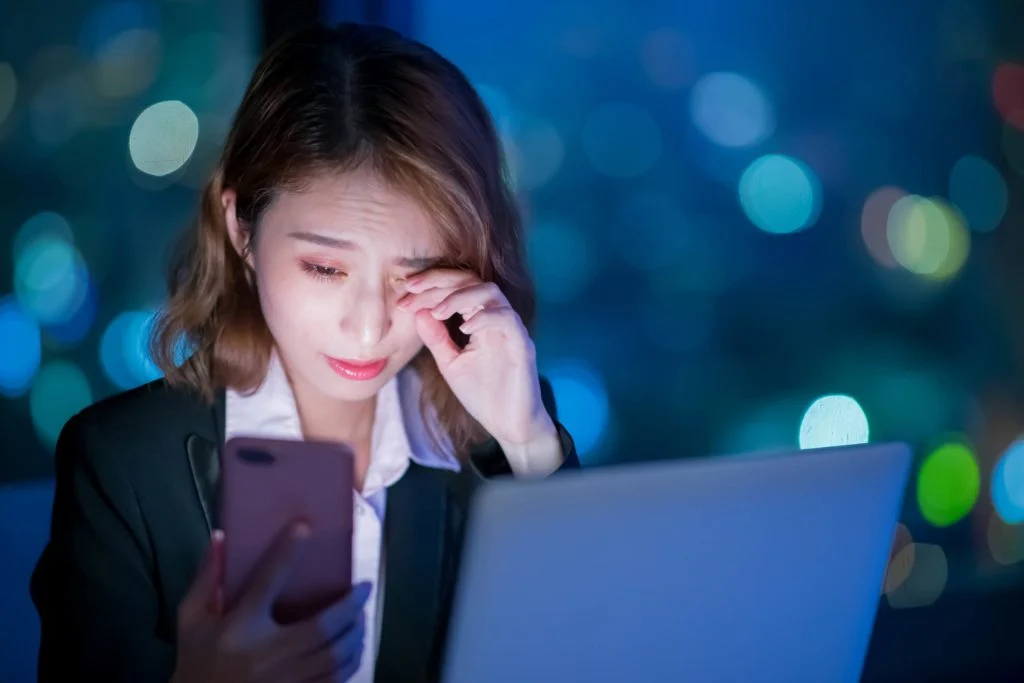
Recognizing the signs of excessive blue light exposure helps identify when intervention is needed:
Visual Symptoms:
- Blurred or double vision
- Difficulty focusing on screen content
- Increased sensitivity to light
- Watery or excessively dry eyes
- Burning or itching sensations
Physical Symptoms:
- Headaches, particularly around the temples
- Neck, shoulder, and back pain
- General eye fatigue and tiredness
- Difficulty keeping eyes open
- Increased frequency of eye rubbing
Sleep-Related Effects:
- Difficulty falling asleep after evening screen use
- Poor sleep quality and frequent waking
- Feeling unrested despite adequate sleep time
- Disrupted natural sleep-wake cycles
Risk Factors and Vulnerable Populations
Certain factors increase susceptibility to blue light-related eye problems:
High-Risk Activities:
- Extended computer work without breaks
- Gaming for multiple hours continuously
- Reading on backlit devices in dark environments
- Using multiple screens simultaneously
- Poor screen positioning and viewing angles
Vulnerable Groups:
- Children and teenagers with developing eyes
- Individuals with pre-existing dry eye conditions
- People with light sensitivity or photophobia
- Those with certain medications affecting light sensitivity
- Individuals with sleep disorders or shift work schedules
Protection Strategies and Solutions
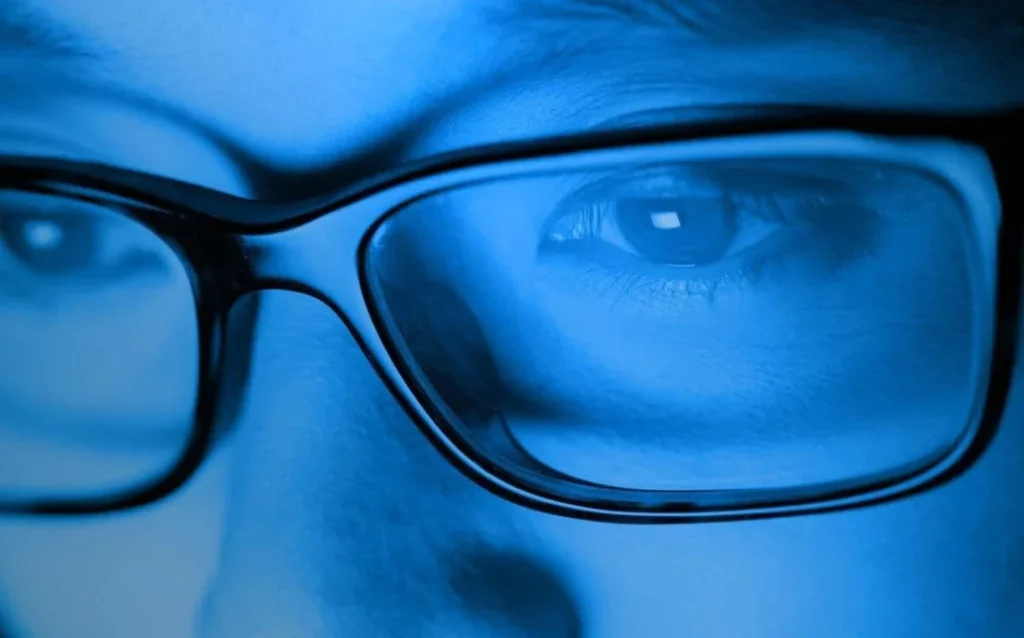
Implementing protective measures can significantly reduce blue light exposure and associated symptoms:
Screen Hygiene Practices:
- Follow the 20-20-20 rule: every 20 minutes, look at something 20 feet away for 20 seconds
- Maintain proper screen distance (arm’s length for computers)
- Position screens slightly below eye level
- Ensure adequate ambient lighting to reduce contrast
- Adjust screen brightness to match surrounding environment
Technical Solutions:
- Use built-in blue light filters on devices
- Install blue light filtering software applications
- Consider blue light blocking glasses
- Upgrade to screens with better blue light management
- Use dark mode settings when available
Environmental Modifications:
- Improve workplace and home lighting
- Use warm-toned LED bulbs in evening hours
- Position screens away from windows to reduce glare
- Create designated screen-free zones and times
- Implement digital curfews before bedtime
Home Remedies and Natural Protection
Several natural approaches can help alleviate blue light-related eye strain:
Eye Care Practices:
- Practice regular blinking exercises to maintain eye moisture
- Use preservative-free artificial tears for dry eyes
- Apply warm compresses to relieve eye fatigue
- Perform eye relaxation exercises and gentle massage
- Ensure adequate hydration throughout the day
Nutritional Support:
- Consume foods rich in lutein and zeaxanthin (leafy greens, eggs)
- Include omega-3 fatty acids in your diet (fish, nuts, seeds)
- Eat antioxidant-rich foods (berries, colorful vegetables)
- Consider supplements after consulting with healthcare providers
- Maintain proper vitamin A intake for overall eye health
Lifestyle Modifications:
- Establish regular sleep schedules
- Create screen-free bedrooms
- Practice outdoor activities to balance near vision work
- Use proper ergonomics for workstation setup
- Take frequent breaks from screen-intensive tasks
When to Seek Professional Help
Consult an eye care professional if you experience:
- Persistent eye pain or discomfort
- Sudden changes in vision quality
- Severe headaches associated with screen use
- Symptoms that don’t improve with protective measures
- Signs of more serious eye conditions
Regular comprehensive eye exams can help detect any underlying issues and provide personalized recommendations for blue light protection.
Prevention and Long-term Eye Health

Maintaining healthy vision in the digital age requires proactive measures:
Daily Habits:
- Implement consistent screen time limits
- Practice good digital hygiene throughout the day
- Maintain proper posture and ergonomics
- Stay hydrated and blink consciously
- Balance screen time with outdoor activities
Technology Management:
- Use device settings to reduce blue light emission
- Schedule automatic blue light filters for evening hours
- Consider upgrading to eye-friendly display technologies
- Regularly clean screens to reduce glare and strain
- Optimize display settings for comfortable viewing
Professional Care:
- Schedule regular comprehensive eye exams
- Discuss occupational eye health with your eye doctor
- Consider specialized computer vision evaluations
- Stay informed about new protective technologies
- Follow professional recommendations for your specific needs
Frequently Asked Questions

Q: Do blue light blocking glasses really work?
A: Research shows mixed results. Some studies suggest modest benefits for digital eye strain symptoms, while others find limited effectiveness. They may help some individuals, particularly for sleep quality, but aren’t necessary for everyone.
Q: Can blue light from screens cause permanent eye damage?
A: Current research hasn’t definitively proven that typical blue light exposure from digital devices causes permanent retinal damage. However, digital eye strain symptoms are real and can significantly impact daily comfort and productivity.
Q: Should children use blue light protection?
A: Children’s eyes are more sensitive to blue light, so limiting screen time and using protective measures is generally recommended. Focus on proper screen habits, adequate breaks, and balanced activities rather than relying solely on filtering technology.
Q: Is blue light worse at night?
A: Blue light exposure in the evening can disrupt circadian rhythms and interfere with sleep quality. The timing of exposure matters more for sleep effects than the total amount of blue light.
Q: How much screen time is too much?
A: While there’s no universal limit, extended periods without breaks increase eye strain risk. Following the 20-20-20 rule and taking regular breaks is more important than total screen time for eye health.
Q: Are some devices worse than others for blue light exposure?
A: Devices vary in blue light emission, but proximity and duration of use matter more than the device type. Smartphones held close to the face may cause more strain than larger screens viewed from appropriate distances.
Conclusion
Blue light exposure from digital devices is a legitimate concern in our technology-driven world, though the long-term effects on eye health are still being studied. What’s clear is that digital eye strain affects millions of people and can significantly impact quality of life and productivity.
The key to protecting your eyes lies in implementing comprehensive strategies that include proper screen hygiene, environmental modifications, and healthy digital habits. While blue light filtering technologies can be helpful, they’re most effective when combined with good screen practices and regular eye care.
As our reliance on digital devices continues to grow, prioritizing eye health through education, prevention, and professional care becomes increasingly important. By taking proactive steps today, you can maintain comfortable vision and protect your eyes for years to come.
Remember that individual responses to blue light vary, so what works best for you may require some experimentation with different protective strategies. When in doubt, consult with an eye care professional who can provide personalized recommendations based on your specific needs and circumstances.

